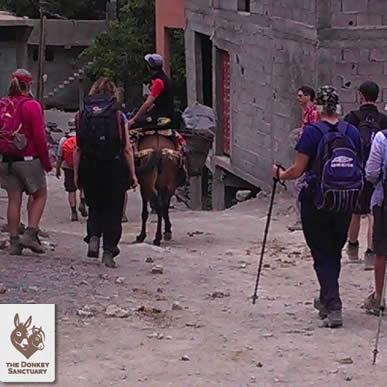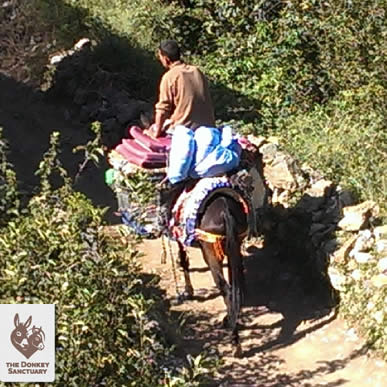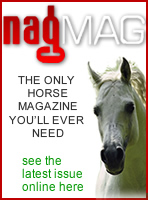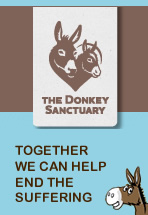
Horseytalk.net Special Interview
Glen Cousquer
SUGGESTIONS TO BE BORNE IN MIND BY TOURISTS
PLANNING TO TREK WITH PACK MULES IN MOROCCO
 Says Glen Cousquer, The Donkey Sanctuary
Says Glen Cousquer, The Donkey Sanctuary
THANK YOU MULE FOR CARRYING MY BAGS!
SO SAID THE BRITISH TREKKER AS HIS GROUP ARRIVED BACK INTO IMLIL. AS HE DID SO, AT LEAST FOUR MULES FILED PAST, LOADED UP WITH HEAVY LUGGAGE.
TWO OF THE MULES SADLY ALSO HAD TO CARRY THE MULETEER.
Over the last five years I have been working as an instructor at the Moroccan Guide School (the CFAMM), where we have introduced mule care and welfare into the curriculum. Our long term aim is to encourage the wider mountain tourism industry to give greater consideration to the animals that form an integral part of the trek team. I therefore took the opportunity to learn more.
I spoke with one of the two guides who was accompanying the group. A student of mine at the CFAMM, it was good to see him and learn how he had been getting on since completing his studies. I asked him about the overloading and he told me that he had raised it and that the lead guide had said that nothing could be done about the problem. On asking them who they were working with, I learnt that the company was Marrakech based, and one of the supposedly better tour agencies here in Morocco. This was subsequently confirmed by the muleteers.
 Clearly even some of the ‘best’ local tour agencies do not yet really understand about animal welfare and do not have policies in place to ensure that animal abuses and exploitation are avoided. That this is so in this case became even clearer upon interviewing the muleteers after the clients had left for Marrakech.
Clearly even some of the ‘best’ local tour agencies do not yet really understand about animal welfare and do not have policies in place to ensure that animal abuses and exploitation are avoided. That this is so in this case became even clearer upon interviewing the muleteers after the clients had left for Marrakech.
The muleteers were eight in number for a group of sixteen clients. This equates to eight mules for twenty-six people (16 clients, 2 guides and 8 muleteers). They had been up to the refuge below the Toubkal, a three day trip that is probably the most commonly undertaken undertaking in the Atlas.
I was surprised and disappointed to learn that the muleteers were only paid ninety dirhams per day by the agent in Marrakech. This fact was confirmed independently by all four muleteers I interviewed. This daily rate is well below a standard rate of 100-150 dirhams. This constitutes exploitation of muleteer and mule. Not only must the muleteer feed his family on this but he also has to shoe his mule (a set of shoes costs 100 dirhams) and buy food (straw and grain) for his mule, all of which are increasing in price!!
A careful search of the agent’s website shows no evidence of any codes of practice being applied to ensure that the mule is protected despite this guarantee on their home page:
’... guarantees for quality, flexibility and reliability, professional and experienced guides, reliable local teams, quality equipment’.
Clearly the guarantee does not extend as far as the muleteer and his mule.
Guarantees are welcome and demonstrate awareness that agencies need to provide reliable professional guides and local teams, capable of delivering a quality experience for their clients. It is important, however, that this be more than window dressing and that agencies consider how these ideas come to have wider meaning and how they can be translated into action. If these agencies genuinely care about the quality of their product they will understand that any care ethic extends beyond the client, taking in all members of the trek team and should, arguably consider the welfare of the environment and local communities.
Failure to pay a decent living wage impacts directly on animal welfare. Maintaining a mule in good health during the busy trekking season is not without costs. Many of these costs are hidden. Certainly the unsuspecting tourist cannot be expected to know about them! But the tour agent in Marrakech most certainly should.
As part of my work here in Morocco I will engage with the agencies in an attempt to open their eyes and get them to change their behaviour. However it is also important that trekkers play their part.
There are ways that the welfare of mules and muleteers could be improved. For example:
 Agencies concerned about remaining competitive could offer an ‘animal welfare supplement’ in the same way that airline passengers are asked to carbon offset.
Agencies concerned about remaining competitive could offer an ‘animal welfare supplement’ in the same way that airline passengers are asked to carbon offset.
In this manner, a separate budget is provided to ensure the mule receives the very best feed available and that calories are supplemented with vegetable oil.
Where the muleteer is underpaid and still has to purchase food for his mule, it is self-evident that the mule will receive less feed or a lower quality of feed. Self-evident yes, but all too easily overlooked!
Such exploitation also makes it less likely that any necessary repairs to the mule’s saddle blanket are undertaken properly and this commonly leads to sores developing on a mule’s back.
Responsible tourists can expect that tour agents think carefully about the mules that work for them and generate their profits. It is a complete certainty that the mule will do all the hard work and receive little or no thanks or reward! As ever, the mule and muleteer are relatively powerless and easily exploited. A good agent will therefore pay a fair wage and have a policy in place that ensures the common problems associated with overloading, inadequate feed and poor quality or poorly maintained harness and tack are all avoided.
Key considerations for trekkers and tour companies using pack mules were provided in an earlier blog. The Association of British Travel Agents (ABTA) have also just published animal welfare guidelines for the tourism industry.
Whilst this story concerns a specific travel agency, it is clear from observing the attitudes and behaviours of the majority of trekking groups that few agencies do have effective measures in place to protect mule welfare. No agency, as far as we know, ensures that humane tethers are used on the mules or insists that stainless steel bits are always used. It is for this reason that almost all mules have evidence of burns and scarring to their forelimbs where they have been tethered with nylon ropes. Similarly, no one seems to have addressed the overloading that occurs when muleteers ride their already heavily loaded mule on downhill sections.
Food for thought
The following suggestions should be borne in mind by the tourist wishing to trek with pack mules in Morocco:
- The recommended weight limit for a pack mule is 50-80kg. On steep terrain where there is a lot of loading on tendons, this should tend towards the lower end of the range. Bearing in mind that the saddle blanket itself weighs around 20kg, the mule should be carrying two bags of 15-20kg and no more!
- You can make a careful note of the weight of your bags on checking in.
- You can yourselves stipulate before the trek starts that you will tip the muleteers on condition that they do not themselves ride their mule. An extra 60-80kg brings the weight up towards 150kg. It is this sort of overloading that, especially in descent, contributes to tendinitis. These are common within the population of pack mules working in the Atlas.
- You should check that your tour operator / travel agent is paying a fair wage. It is suggested that this should be at least 110 dirhams a day. The best tour agents will pay 130-150 dirhams.
- A separate budget should be provided to pay for a mule’s shoes and feed.



